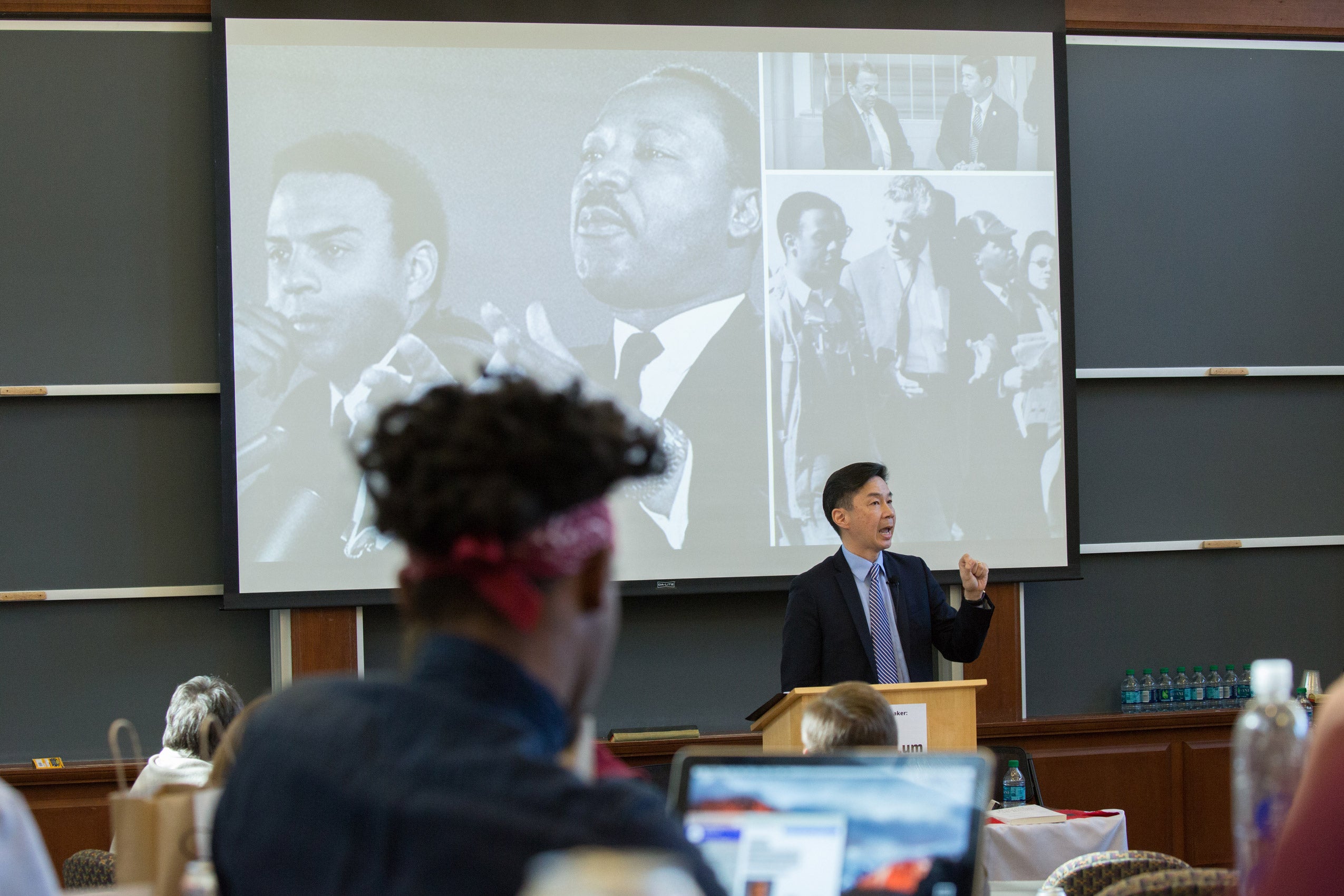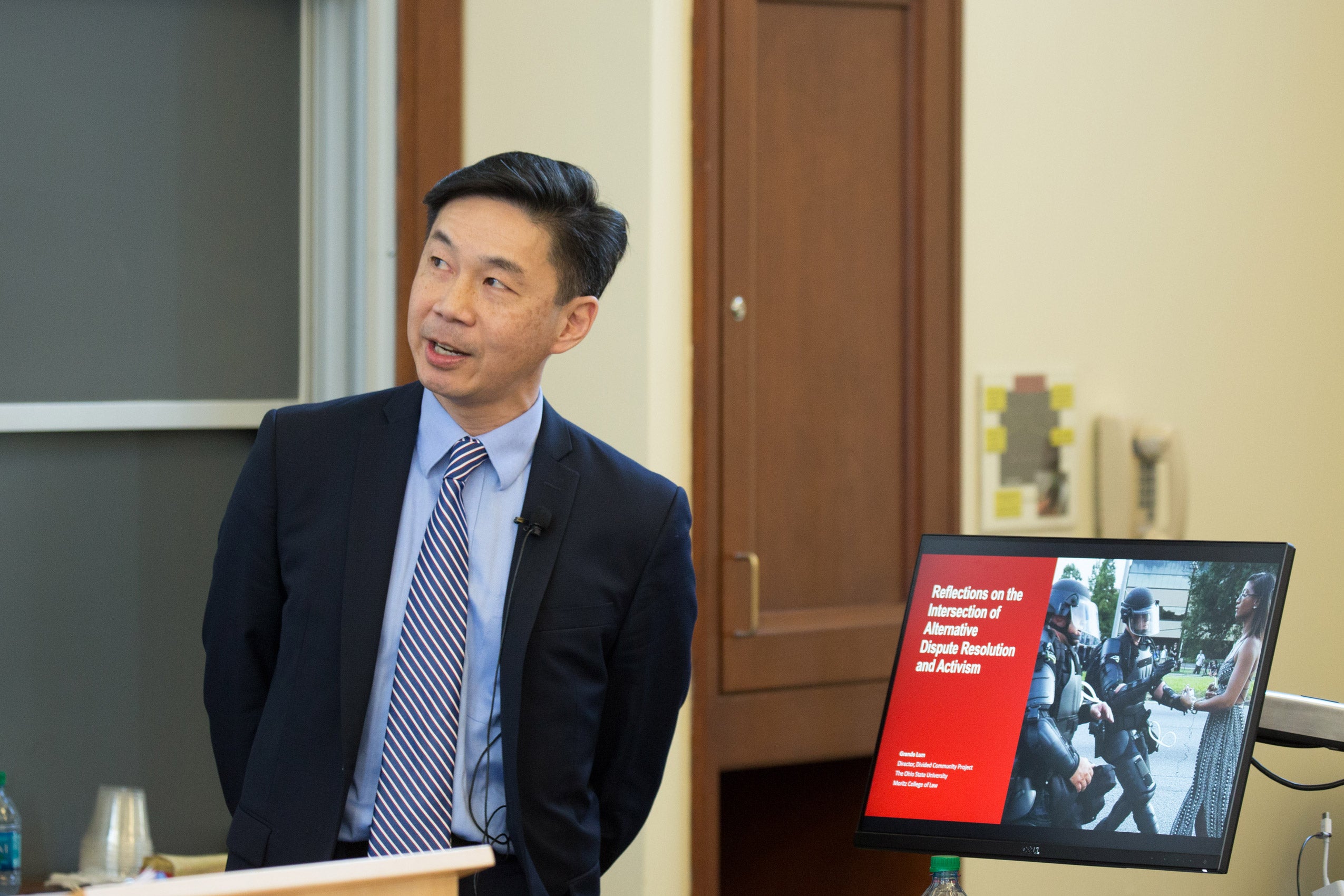Within minutes of the Aug. 10, 2014, fatal police shooting in Ferguson, Missouri of an unarmed black teenager named Michael Brown, a civil rights group alerted the U.S. Justice Department’s Community Relations Service, or CRS. Four days later, President Barack Obama ’91 publicly announced that CRS was on the ground in Ferguson, and two days after that Attorney General Eric Holder was meeting with Ferguson residents at a CRS-organized town hall. Ultimately, the DOJ entered into a consent decree agreement with the City of Ferguson after issuing a searing report documenting the city’s civil rights violations.
“We were likely the first federal group to deploy to Ferguson, and the first federal group to speak to a broad range of protesters,” said Grande Lum ’91, who directed CRS from 2012 to 2016. He now directs the Divided Community Project at Ohio State University’s Moritz College of Law.

Lum was on the Harvard Law campus Feb.17, 2017, to deliver the keynote address of the Harvard Negotiation Law Review’s 22nd Annual Symposium, “Reflections on the Intersection of Alternative Dispute Resolution and Activism.” Adriel Borshansky [Harvard Divinity School ’15], a clinical fellow with the Harvard Negotiation & Mediation Clinical Program (HNMCP), explained to the law professors, students, and ADR practitioners in attendance, “What makes today’s symposium new and significant is the push to explore how the field of ADR can learn from activists, and vice-versa.” The symposium also featured a conversation with civil rights activist DeRay McKesson as well as two panel discussions: “Theoretical Perspectives: Navigating Questions of Power and Neutrality,” moderated by Clinical Professor Robert C. Bordone ’97, director of HNMCP; and “Internal Dilemmas: Navigating Personal Convictions and the Work of Alternative Dispute Resolution,” moderated by Lecturer on Law and Clinical Instructor Rachel Viscomi ’01.
“I went to law school with the idea of becoming a civil rights litigator, not a civil rights mediator,” Lum said. “When I came to this law school in 1988, I had the idea of avenging wrongs, not negotiating them.” His perspective — and career path — changed when he took a negotiation course with Professor Roger Fisher LL.B. ’48, co-author of the classic “Getting to Yes” (1981).
Can a mediator, a neutral party by definition, advance the cause of justice? Lum quoted Bishop Desmond Tutu: “‘If you are neutral in situations of injustice, you have chosen the side of the oppressor. If an elephant has its foot on the tail of a mouse and you say you are neutral, the mouse will not appreciate your neutrality.’ When you hear that, who would want to be neutral?” Lum said. But he then went on to distinguish between a neutral who acts as a passive bystander and an “active neutral” who helps parties achieve a desired goal. Lum reminded his audience that CRS was created by Title X of the 1964 Civil Rights Act with the initial charge of helping Southern hotels, restaurants, and others in the business of public accommodations to peacefully desegregate.
Related: Grande Lum: Director of the Community Relations Service at the U.S. DoJ, Lectures in the “Negotiation Workshop” (via the Harvard Negotiation and Mediation Clinical Program)
More recently, “when CRS did its work in Sanford, Florida, following the Trayvon Martin shooting, this third-party role was crucial in keeping the peace and in facilitating voices that were demanding to be heard,” Lum said. “The CRS conciliators who did the work were there … to make sure the protesters and the officials stayed safe during the unrest, that it actually stayed civil. City officials went out of their way to get parade permits and drive people to protests. There was a lot of civil protesting, but not a single arrest.”
Right-wing media, Lum noted, have criticized this approach. “Social media like Breitbart.com, radio talk show hosts like Rush Limbaugh, and cable TV hosts like Sean Hannity especially during the Trayvon Martin situation blamed CRS for working with protestors to increase unrest,” Lum said. The Heritage Foundation, a conservative think-tank, has called for the elimination of CRS.
Lum noted that, when we think about social change, we tend to remember the grand breakthroughs, like Brown v. Board, or Stonewall. But, “the reality is that change is often more incremental and continuing rather than one shining moment,” Lum said. “I would argue that negotiation and conflict resolution has always been a part of every movement in every phase.”
“Activism creates leverage. Activism creates power. Activism changes the status quo. And change happens when in addition to legislative and litigation victories, people work out solutions on their own,” Lum said. “That’s where those of us in ADR can play an important GPS-navigational role.”
